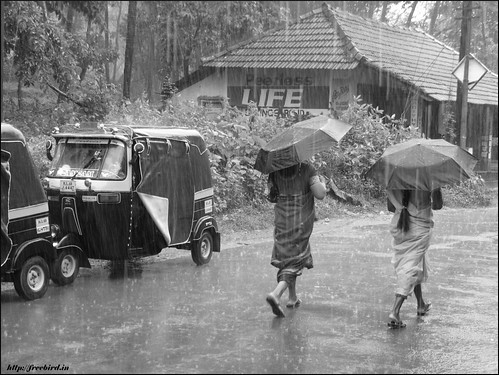
When I had written so much about monsoon rains and Karkitakam and my longing to enjoy the rain, I think Lord Varuna decided to grant me my wishes. Starting from 6.30pm on Friday till 4 am on Sunday, we had incessant rains in Hyderabad. It just poured and poured, throwing life out of gear for working people.
When it started on Friday evening, I remembered the old Malayalam saying, “Andhikku vanna mazhayaum, Sandhyakku vanna virunnum vittu pokilla,” which means that the rain that starts at the nightfall and the guest who comes around the same time are sure to stay. I say old Malayalam saying because the latter part of the saying may not be relevant today. This was truer some 50 years ago or before when the places were not connected well and the transportation facilities were minimal. So a guest who dropped in after 4 in the evening was expected to stay for dinner. The first part of the saying holds good even today for nature has clearly not changed. The rain that started light soon became heavy and by the time we turned in, it had worked up to a nice rhythm. The power went off soon enough to return only after some 18hrs.
On Saturday morning, when we woke up, there was no power (which meant no hot water for our bath), no water (in the taps I mean, there was plenty of water around the house), the maid did not turn up (I had to do the dishes) and there was no sign of the rain stopping. Instead of cribbing (to myself, who else?), I decided to enjoy the situation by planning a simple, typical Karkitakam menu of
Nazhukari and vegetable
kootu (nazhukari recipe later) and pulled a chair near the window with my embroidery, so that I could see the rain in all its glory. (No electricity and so no mixie for grinding masalas and coconut and no grinding stone of olden times for manual grinding either; so what else to cook?) Though we have had continuous rains for days together in Bangalore, I could never sit and enjoy the rain as it were. Those days, I was busy with a full time job and a family with two growing kids and aging parents-in-law, so the moment it started raining, my thoughts were always tactical, how I would reach the office or home as the case may have been or how the children would reach home from school, or how my moped would go through all the water logged areas, etc. Not much time to enjoy the rain. These days, although I am comparatively free, we don’t have those type of rains. So now I did not want to miss my God given opportunity. It was like the typical Karkitakam rains of Kerala, where it would work up to a crescendo and start weakening down and again go up and again come down. As in Kerala, we are living in a house with tiled (the famous mangalore tiles, of course) roof and the patter of water falling from the awnings on to the paved porch was like music to my ears. Sitting there doing my embroidery and watching the rain took me back to my Puthucode days.

All the houses with tiled roof had a metallic gutter on the roof where the roof sloped and the rain water would be collected in this gutter and would be routed either to a large sink called
nadumittam or to the open outside the house. When there were heavy rains, water would pour through this opening and for children like us who had not seen anything beyond our village, it was like watching the Niagara. We would go and stand in the water (and get spanked for inviting cold and fever in the rainy season) and splash the water on each other and all around (Veshu, our maid, would admonish us saying, “I just swabbed the place and you have splashed water again, get inside children.” Yes those days, maids could admonish us; they were a part of the family in villages).
The toilets were far away in the backyard and we had to wait for the rain to stop and we had to go up and down a few steps and walk a few meters of a slippery stretch to reach the toilets. Those days, most of the houses did not have a roof on the toilet. Just outside our toilet there was a huge tamarind tree. When the rain stopped and we got inside the toilet, all the water trapped on the leaves and branches would start dripping on us in a simulated rain. Once again our mother would scold us, you got wet again? I was lost in all those sweet memories, when I was woken by the “drip, drip” on my head. I just looked up to see, water leaking from the tiled roof. This completes the picture, I thought. I moved from where I was and went around the house to see more drips in all the rooms. I kept small cups and buckets wherever possible to collect the dripping water. As the drip got worse I started worrying about moving books, electronics etc away from the drips. Thankfully it didn’t get to that.

In Puthucode, we used to keep big
Arikkanchattis and
Chembus, wherever there were big leaks. Once we had kept a big Chembu (this is a huge round pot about 4 to 5ft in diameter used to boil paddy, made of copper, hence the name Chembu) in our kitchen to catch the dripping water. The sides of the chembu were cracked and had jagged ends. It was about 7.30pm and there was no electricity. My brother and our cousin, the same duo who were mentioned in
my earlier post, were running around the house, playing. Suddenly there was a loud noise followed by the crying of the two. We all rushed towards the source of the noise. What did we find? The two had fallen down, my brother inside and the other outside the chembu. The child outside the chembu escaped without much injury. The jagged ends of the chembu had pierced the cheeks of the other one who had fallen inside the chembu and there were three holes into his mouth cavity. After the preliminary awws and ohs and blaming the mothers for not minding the children and scolding the unscathed child for making the other fall, etc., when some calm was restored, our
Kalathappa ordered for the doctor to be called. And what did the injured child say? I can still remember his saying, “Amma give me food before the doctor comes, otherwise he will say, don’t give him any thing to eat till tomorrow.” We all burst out laughing inspite of ourselves. And to see the trouble my brother’s son gives his mother at each meal time now, takes me back to those days when children actually looked forward to eat.
That the doctor came and prescribed some pills and the wounds healed without any antibiotics and sutures would be hard to believe these days.
The rain is likely to continue for another 36 hrs says the met dept.













 In Puthucode, we used to keep big Arikkanchattis and Chembus, wherever there were big leaks. Once we had kept a big Chembu (this is a huge round pot about 4 to 5ft in diameter used to boil paddy, made of copper, hence the name Chembu) in our kitchen to catch the dripping water. The sides of the chembu were cracked and had jagged ends. It was about 7.30pm and there was no electricity. My brother and our cousin, the same duo who were mentioned in my earlier post, were running around the house, playing. Suddenly there was a loud noise followed by the crying of the two. We all rushed towards the source of the noise. What did we find? The two had fallen down, my brother inside and the other outside the chembu. The child outside the chembu escaped without much injury. The jagged ends of the chembu had pierced the cheeks of the other one who had fallen inside the chembu and there were three holes into his mouth cavity. After the preliminary awws and ohs and blaming the mothers for not minding the children and scolding the unscathed child for making the other fall, etc., when some calm was restored, our Kalathappa ordered for the doctor to be called. And what did the injured child say? I can still remember his saying, “Amma give me food before the doctor comes, otherwise he will say, don’t give him any thing to eat till tomorrow.” We all burst out laughing inspite of ourselves. And to see the trouble my brother’s son gives his mother at each meal time now, takes me back to those days when children actually looked forward to eat.
In Puthucode, we used to keep big Arikkanchattis and Chembus, wherever there were big leaks. Once we had kept a big Chembu (this is a huge round pot about 4 to 5ft in diameter used to boil paddy, made of copper, hence the name Chembu) in our kitchen to catch the dripping water. The sides of the chembu were cracked and had jagged ends. It was about 7.30pm and there was no electricity. My brother and our cousin, the same duo who were mentioned in my earlier post, were running around the house, playing. Suddenly there was a loud noise followed by the crying of the two. We all rushed towards the source of the noise. What did we find? The two had fallen down, my brother inside and the other outside the chembu. The child outside the chembu escaped without much injury. The jagged ends of the chembu had pierced the cheeks of the other one who had fallen inside the chembu and there were three holes into his mouth cavity. After the preliminary awws and ohs and blaming the mothers for not minding the children and scolding the unscathed child for making the other fall, etc., when some calm was restored, our Kalathappa ordered for the doctor to be called. And what did the injured child say? I can still remember his saying, “Amma give me food before the doctor comes, otherwise he will say, don’t give him any thing to eat till tomorrow.” We all burst out laughing inspite of ourselves. And to see the trouble my brother’s son gives his mother at each meal time now, takes me back to those days when children actually looked forward to eat.















